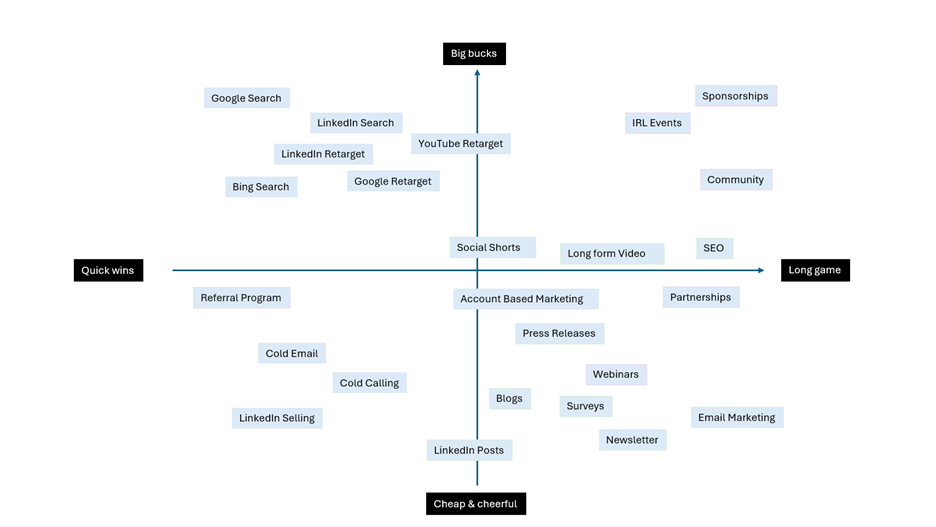How do you achieve Rule of 40?
TekStack believes that Rule of 40, or Profitable Efficient Growth is achieved four ways, in order:
- Improving win rates
- Increasing the size of your funnel
- Retaining and growing your customers
- Protecting your profits
We call this Revenue Performance.
Improve your win rate
This is the first thing you need to fix. No point spending one incremental dollar on sales and marketing until you get your win rate to a happy place. Moving your win rate from 20% to 40% is not a 20% improvement in revenue booking. It’s a 100% improvement. Win rate has an outsized impact on your Sales Velocity.
Let’s say you are a tech company with 20 deals, average contract value of $50K, taking 120 days to close. If your win rate is 20%; your sales velocity is $1,667; or you are on path to closing this much each day. Now, if you can improve your win rate to 35% your sales velocity increases to $2,916; or $1M per year.
# of Opportunities ×Win Rate % ×Average Deal Size
Sales Cycle Length (days)
The fastest way to improve win rate is to ensure consistency in how you sell. You’re losing deals you shouldn’t be losing.
Create the right sales motions
- Targeted Account Seling
- Marketing Lead to Sales Handoff
- Discovery Calls
- Opportunity Qualification
- Call Planning
- Mutual Action Plans
- Managing competitors
- Demonstrations that win
- Services Estimating & Proposal Delivery
- Addressing Objections
- Closing deals
There are key moments for every buyer journey, make sure your sellers are aligning their actions to the buyers.
Develop the right selling tools.
Make sure your sellers have the right tools to get the job done. Putting the right tools in place will create efficiency for your sellers, and make sure each seller is applying the best practice. Otherwise, they’ll just make up their own approach.
- Outbound Prospecting Sequences
- Cold Call Scripts
- Sales Collateral
- Sales Presentations
- Sales Proposals
Consistent & Reinforced Execution
Help sellers by setting goals and measuring results.
- Calling & Email Activity
- Weekly deal reviews
- Updating buyer activity records
- Updating opportunity information (Close dates, deal values, stages)
- Call Planning, Action Planning, Account Strategies
Increase the Size of your Funnel
The next most important area of focus is increasing the size of your funnel. You don’t want just any deals, you want high fit, winnable deals entering the funnel.
Define your Ideal Customer Profile
Do a win analysis to figure out where you win and where you lose. Interview customers and lost prospects to get the information you need. Define a narrow segment where you are most likely to win. For most companies, to win 10 deals per year, you don’t need a market size greater than 8,000-10,000 accounts.
Often the best way to pick a segment is to focus on demographics like region, size, and/or vertical. But there are other criteria as well like technographic (what technology are they running), and psychographic (are they an early or late mover on technology adoption?).
Hone your Message
Buyers are faced with a sea of options. The status quo can sometimes be the safest option of all. In the face of increasing competitive pressure, how does your company stand out from the rest? More and more companies are choosing messaging inspiration from top brands. But these companies don’t need to stand out because they get massive tail winds from even more massive marketing budgets. They can afford to use lofty non-descript, inclusive messaging. You can’t. Get sharp, identify the market problems and how you fix them better than your competitors.
Create a dataset of your buyers
Inbound leads are great, but you probably can’t depend on them, so you’ll need to source a list of all your ideal customers. Load them into your CRM. Most likely, you will have multiple contacts to target in one account. Use an account centric approach to organize and track your data. There are great data sources and lots of tricks to getting data. Make sure your data source is high quality.
Engage with your buyers
Selling B2B requires you to engage with a buyer upwards 40 times before they take action. In fact a recent report from HockeyStack suggests it takes a whopping 266 touchpoints to close a deal in 2024. And you’ll need to do this across multiple channels. Email, calling, LinkedIn; but they also need to find you on their own through ads, community, referrals, video content, events, and other channels. It’s estimated that less than 5% of your potential buyers are in an active buying cycle. So even if you hit them and they take notice, the timing may not be right, you’ll need to reinforce your message over an over again until they are in market.

Pick tactics that have are cost efficient. To achieve profitable growth the total sales and marketing cost should not exceed the total amount of ARR you collect in a year. If you are trying to close $1M in new ARR, don’t spend more than $1M to get it. Does that sound like a ridiculous number? The biggest software companies you admire spend up to $20 to get $1 in ARR. This metric is called Sales Efficiency or the Sales Magic Number.
Retain & Grow your Customers
You’re closing more deals and building a bigger funnel. Fantastic! Now its time to grow and retain your customers. This doesn’t happen by accident; it requires programs and people.
Build an Onboarding Process
Buyer remorse can quickly set in with B2B technology projects, mostly because they are highly conceptual, expensive, and have high failure rates. A bad project can ruin your buyer’s career. You can prevent all of this with a well-defined onboarding process. Be clear with your communication at all levels, be diligent with your project management, track issues, actions, and risks. Most importantly, this process begins pre-sale, be sure to set correct expectations with buyers and manage against them.
Provide Self-Service options
This could be in the form of a knowledge base portal, or even building a community of users. Give your customers more options than just contacting your support team.
Get great at support
On that note, make sure you create support terms including response times based on severity. Beat those commitments every time. Provide your customers with multiple support channels like email, portal, phone, or in-app. Make sure you track the tickets and build in email notifications at key times including ticket creation and resolution. Capture customer satisfaction results.
Segment your customers
You’ll go broke if you try to provide the same level of proactive customer success to all your customers. Identify your customers in one of four segments. The idea is to identify where each customer falls so that you can prioritize your engagement with the customers that want to engage with you.
Build automated Customer Success
For most customers, they won’t require a high touch customer success strategy, it will be enough to provide automated customer success. Things like monthly webinars and newsletters can go a long way to keep these customers engaged.
Build a Customer Success Model
For the ‘strategic’ customers, make sure you have a CS model that captures their business objectives and specifically how you help them achieve those objectives. If they are not engaged with this process, demote them from a high touch model. Capture these objectives and track progress each quarter.
Track Customer Health
This does not need to be complicated. Temperature gauge of red, yellow, green works fine, even if just manually set. Net Promoter Score can be a simple way to capture sentiment.
Give employees a 360 view of the Customer
So often, your team will need to make five internal phone calls just to get a read on how it’s going with a customer. Do them a favor and get that information in their fingertips.
Protect your Profits
You’ve got your revenue game sorted, now there are some important processes that will ensure this turns revenue growth into profitability. This is another key element to Rule of 40.
Customer Profitability
You need to know the profitability of each customer, both annually and over their lifetime. Include all revenue versus support cost plus delivery cost. Include the customer acquisition cost or the sales magic number of the customer cohort to get a true measure of profitability. Be ruthless with the results. Your best customers might not be who you think.
Project Profitability and Resource Efficiency
Are your projects profitable? Do you know which are the most profitable and why or the least and why? Do you know who are your most efficient resources? How do efficient resources impact project profitability? Do you know your least efficient resources? Can you proactively identify projects where profitability is slipping? To achieve the rule of 40, you need to carefully manage project profitability and resource efficiency. A few bad apples can ruin the bunch. There can often be a small handful of projects that can have a big impact on profitability. Tracking unprofitable projects is like a smoke detector. You can find the source of the issue and correct it.
Manage your Subscription Revenue
Create a renewal process that ensures you calculate the renewed software values correctly. It easy to miss add-on orders or contracted price increases.
Get on top of your invoices
Software orders, add-on orders, renewals, services invoicing. Its not uncommon to miss billing milestones, or a few billable hours per resource each month.
Integrated Accounting
Ideally, your entire billing and invoicing process can be managed without manual intervention so that you can get invoices out the door quickly but also close the month quickly. The longer it takes the harder it is to source root problems related to product lines, divisions, department costs, or direct sales costs.


